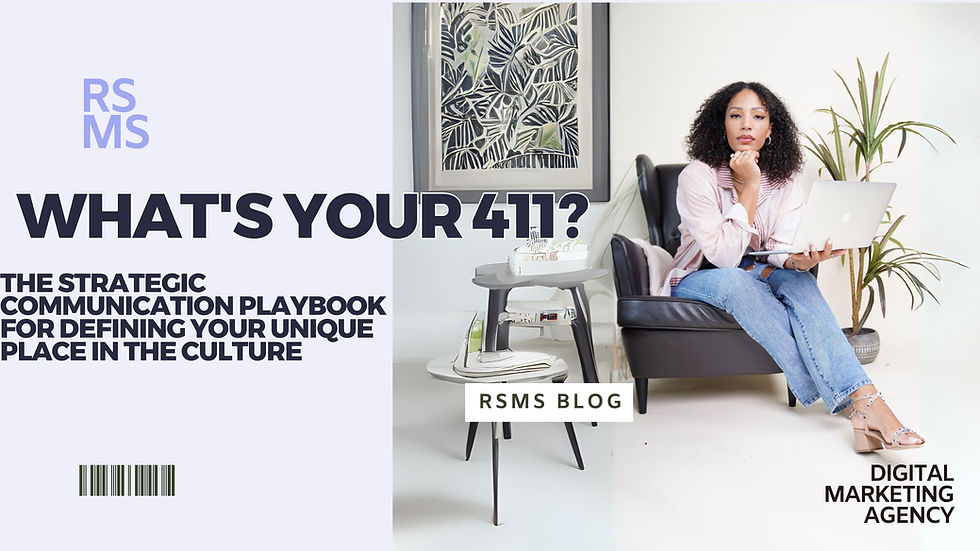Understanding Your Audience: The Key to Effective Branding
- funmilayo7
- Aug 5, 2024
- 3 min read

Ever feel like your brand message is playing a solo in an empty concert hall? You’ve got your business marketing game on point, but somehow, your message just isn't hitting the high notes. Here’s the scoop: something crucial is missing. It’s like baking a cake and forgetting the sugar. Sure, it looks like a cake, but one bite and you’re reconsidering your life choices. So, what’s this elusive, magical ingredient? It’s knowing your target audience.
The Challenge Faced With Not Understanding Your Audience
Standing out in today’s market is more than just having a catchy slogan or a slick logo. Picture this: you’ve got a tagline that could make a monk laugh, an optimized website that runs faster than a cheetah on Red Bull, and a branding strategy that’s ready to pop off. Yet somehow, connecting with your potential customers feels off. Something is not sitting right.
This is because you’ve skipped a crucial step in understanding your audience. Why is this potentially dangerous? Because you’re working hard to reach either the wrong people or no one at all. You’re sending out messages that miss the mark, targeting the wrong crowd, or speaking a language your ideal customers don’t understand. This leads to missed opportunities, diminished returns, and you feeling depleted and confused on what to do next.

What Does a Target Audience Analysis Include?
The key to overcoming this challenge lies in conducting a comprehensive target audience analysis. A thorough target audience analysis includes understanding and digesting the four main types of target audience.
4 Types of Target Audiences
According to Bain and Company, businesses that use customer segmentation to generate and tailor their marketing strategies generate a profit growth of 15% yearly, unlike businesses that don't and generate a 5% profit growth yearly.
To effectively reach and engage your ideal customer, you need to know who they are, not on a general surface level, but in-depth. Below are the four audience types to consider:
Users
This audience group refers to the people who are in direct contact or interaction with your product or service or, in this case, solution. For example, if you own a children’s company, your target audience might be kids aged 5 – 11. They are the ones who would use your solution, so any advert or message would be focused on them.
Their experience and satisfaction are vital, and they can become loyal customers/users if they admire your solution.
Buyers
These are the people who pay for your solution, either for themselves or for someone else. It’s important to note that although buyers might not always be your end-users, they are crucial for the financial success of your business. Using the above example, although the kids are the users, they can’t purchase the toys themselves, making the parents or guardians the buyers - the decision-makers who ultimately pay (or don’t pay) for the toy.
Beneficiaries
Beneficiaries are those who benefit directly or indirectly from your solution. Still using the toy company as an example, the beneficiaries could be educators or daycare providers who see improvements in the children's learning or playtime through playing with your toys.
Even though they didn't make the purchase decision, their positive feedback can boost the buyers' (parents') decision to purchase more toys.
Influencers
These groups or individuals are those who encourage or support the sales/decision of your solution. These include parenting bloggers, past clients, social media personalities, or relevant public figures with a large following.

How to Find Your Target Audience
You need to find your target audience in order to understand them. Below are ways to go about that. Note: It involves research, target audience analysis, and strategic thinking. While you can kick-start the process, you will need the help of a marketing services agency to get accurate and result-driven data.
Market Research: Start by understanding your target audience. Then, examine industry trends, market demands, competitor analysis, and customer preferences.
Customer Survey: Conduct interviews, surveys, questionnaires, and polls to gather insights into their demographics, likes and dislikes, and preferences
Data Analysis: Analyze the data obtained from the surveys, sales records, social media insights, and website analytics to identify common characteristics among your target audience.
Create Customer Persona: Based on all collected and analyzed data, develop detailed profiles of your target audience.
Test and Fine-tune: Once you are done, test-run it through targeted marketing campaigns. Keep fine-tuning it, as it helps you accurately target your audience.
Conclusion
In the world of branding, knowledge is power. Understanding your target audience isn't just a box to tick off your marketing checklist—it's the foundation for crafting a brand that resonates, engages, and converts. By understanding them, you are ensuring your brand messaging hits the mark every time.
At Ruth Sherrill Marketing Services, we turn audience understanding into branding excellence, helping you connect, engage, and thrive.
To take your business to the next level, get in touch with us. You can also follow us on Instagram, Pinterest, and TikTok.
.png)



Comments